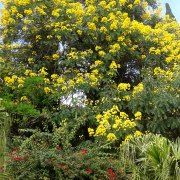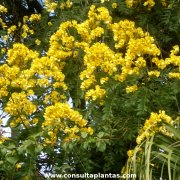Care of the tree Senna spectabilis or Whitebark senna |
|
The genus Senna, family Fabaceae, comprises 250 species of shrubs and trees native to temperate regions of all continents (especially South America and Australia). Many species of the genus Cassia are included in this genus. Some species are: Senna spectabilis, Senna didymobotrya, Senna corymbosa, Senna artemisioides, Senna multiglandulosa, Senna sturtii, Senna candolleana. Common names: Whitebark senna, Spectacular cassia. This species is native to South and Central America. They are deciduous trees with a rounded crown that reach 12 meters (39.37 feet) in height. The leaves are paripinnate, bright green in color and are made up of more or less elliptical leaflets. The showy yellow flowers appear in large axillary clusters and are scented. They bloom from late summer until late fall. The fruits are black pods up to 30 cm (11.8") long. Whitebark senna is used as an isolated specimen in the garden but is also very suitable for alignments in parks, avenues or squares. Senna spectabilis grows in full sun or light shade exposure and in hot climates. It does not resist frost; the winter safety temperature is 5 ºC (41 ºF). Spectacular cassia does not resist calcareous soils; use a light garden soil that contains organic matter. Water frequently, without flooding, so that the soil is always damp and does not dry out completely. Fertilize in early spring with compost or manure. Whitebark senna does not need pruning. Senna spectabilis is a quite resistant plant to pests and diseases; it can be attacked by aphids if it suffers from drought. Spectacular cassia is propagated by woody cuttings or from seeds sown in spring. |
Images of the tree Senna spectabilis or Whitebark senna |
Find plants
Senna spectabilis or Whitebark senna | Care and Growing
© 2025 FavThemes

